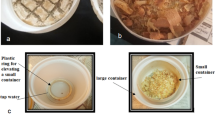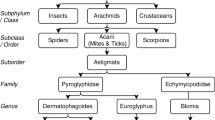Abstract
The house dust mites,Dermatophagoides farinae, D. pteronyssinus andEuroglyphus maynei, are prevalent in homes in humid geographical areas throughout the world. These mites thrive in humid environments in human dwellings where there is no liquid water to drink. However, their bodies contain 70–75% water by weight, which must be maintained in order to reproduce. Their primary source of water is water vapor which is actively extracted from unsaturated air. At relative humidities above 65–70%, adequate amounts of water can be extracted from unsaturated air to compensate for that lost by all avenues. Active uptake is associated with ingestion of a hyperosmotic solution which is secreted by the supracoxal glands. Active mites do not survive longer than 6–11 days at RHs ≤50%. They survive extended dry periods by forming a desiccation-resistant protonymphal stage which can survive for months at RHs below the critical humidity for active stages. Feeding rate and allergen production is directly influenced by RH. Mites feed, multiply, and produce more fecal matter at higher RHs than at lower ones.
Similar content being viewed by others
References
Andersen, A., 1988. Population growth and developmental stages of the house dust mite,Dermatophagoides pteronyssinus (Acari: Pyroglyphidae). J. Med. Entomol., 25: 370–373.
Arlian, L.G., 1975a. Water exchange and effect of water vapor activity on metabolic rate in the dust mite,Dermatophagoides. J. Insect Physiol., 21: 1439–1442.
Arlian, L.G., 1975b. Dehydration and survival of the European house dust mite,Dermatophagoides pteronyssinus. J. Med. Entomol., 12: 437–442.
Arlian, L.G., 1976. Mites and house dust allergy. J. Asthma Res., 13(4): 165–172.
Arlian, L.G., 1977. Humidity as a factor regulating feeding and water balance of house dust mites,Dermatophagoides farinae andD. pteronyssinus (Acari: Pyroglyphidae). J. Med. Entomol., 14: 484–488.
Arlian, L.G., 1979. Significance of passive sorption of atmospheric water vapor and feeding in water balance of the rice weevil,Sitophilus oryzae. Comp. Biochem. Physiol., 62A: 725–733.
Arlian, L.G., 1989. Biology and ecology of house dust mites,Dermatophagoides spp. andEuroglyphus spp. Immunol. Allergy Clin. N. Am., 9: 339–356.
Arlian, L.G. and Eckstrand, I.A., 1975. Water balance inDrosophila pseudoobscura, and its ecological implications. Ann. Entomol. Soc. Am., 68: 827–832.
Arlian, L.G. and Staiger, T.E., 1979. Water balance in the semiaquatic beetle,Peltodytes muticus. Comp. Biochem. Physiol., 62A: 1041–1047.
Arlian, L.G. and Veselica, M.M., 1979. Review: Water balance in insects and mites. Comp. Biochem. Physiol., 64A: 191–200.
Arlian, L.G. and Veselica, M.M., 1981a. Re-evaluation of the humidity requirements of the house dust miteDermatophagoides farinae (Acari: Pyroglyphidae). J. Med. Entomol., 18: 351–352.
Arlian, L.G. and Veselica, M.M., 1981b. Effect of temperature on the equilibrium body water mass in the miteDermatophagoides farinae. Physiol. Zool., 54: 393–399.
Arlian, L.G. and Veselica, M.M., 1982. Relationship between transpiration rate and temperature in the miteDermatophagoides farinae. Physiol. Zool., 55: 344–354.
Arlian, L.G. and Wharton, G.W., 1974. Kinetics of active and passive components of water exchange between the air and a mite,Dermatophagoides farinae. J. Insect Physiol., 20: 1063–1077.
Arlian, L.G., Bernstein, I.L. and Gallagher, J.S., 1982. The prevalence of house dust mites,Dermatophagoides spp., and associated environmental conditions in homes in Ohio. J. Allergy Clin. Immunol., 69: 527–532.
Arlian, L.G., Woodford, P.J., Bernstein, I.L., et al., 1983. Seasonal population structure of house dust mites,Dermatophagoides spp. (Acari: Pyroglyphidae). J. Med. Entomol., 20: 99–102.
Arlian, L.G., Rapp, C.M. and Ahmed, S.G., 1990. Development ofDermatophagoides pteronyssinus (Acari: Pyroglyphidae). J. Med. Entomol., 27: 1035–1040.
Boudreaux, H.B., 1958. The effect of relative humidity on egg-laying, hatching and survival in various spider mites. J. Insect Physiol., 2: 65–72.
Brandt, R.L. and Arlian, L.G., 1976. Mortality of house dust mites,Dermatophagoides farinae andD. pteronyssinus, exposed to dehydrating conditions or selected pesticides. J. Med. Entomol., 13: 327–331.
Brody, A.R. and Wharton, G.W., 1970.Dermatophagoides farinae: ultrastructure of lateral opisthosomal dermal glands. Trans. Am. Microbiol. Soc., 89: 499–513.
Brody, A.R., McGrath, J.C. and Wharton, G.W., 1972.Dermatophagoides farinae: the digestive system: J.N.Y. Entmol. Soc., 80: 152–177.
Brody, A.R., McGrath, J.C. and Wharton, G.W., 1976.Dermatophagoides farinae: the supracoxal glands. J.N.Y. Entomol. Soc., 84: 34–47.
Carswell, F., Robinson, D.W., Oliver, J., et al., 1982. House dust mites in Bristol. Clin. Allergy, 12: 533–545.
Cross, H.F. and Wharton, G.W., 1964. A comparison of the number of tropical rat mites and tropical fowl mites that fed at different temperatures. J. Econ. Entomol., 57: 439–443.
Cutcher, J., 1973. The critical equilibrium activity of nonfeedingTyrophagus putrescentiae (Acarina: Acaridae). Ann. Entomol. Soc. Am., 66: 609–611.
Devine, T.L., 1969. A systematic analysis of the exchange of water between a miteLaelaps echidnina and the surrounding vapor. Ph.D. Dissertation, Ohio State University, Columbus, OH, 79 pp.
Devine, T.L., 1977. Incorporation of tritium from water into tissue components of the booklouseLiposcelis bostrychophilus J. Insect Physiol., 23: 1315–1321.
Devine, T.L., 1982. The dynamics of body water in the booklouse,Liposcelis bostrychophilus (Badonnel). J. Exp. Zool., 222: 335–351.
Devine, T. and Wharton, G.W., 1973. Kinetics of water exchange between a mite,Laelaps echidnina, and the surrounding air. J. Insect Physiol., 19: 243–254.
Domrow, R., 1970. Seasonal variation in numbers of house-dust mite in Brisbane. Med. J. Aust., 2: 1248–1250.
Dusbábek, F., 1975. Population structure and dynamics of the house dust miteDermatophagoides farinae (Acarina: Pyroglyphidae) in Czechoslovakia. Folia Parasitol. (Praha), 22: 219–231.
Ellingsen, I.J., 1974. Comparison of active and quiescent protonymphs of the American housedust mite. Ph.D. Dissertation, Ohio State University, Columbus, OH, 82 pp.
Ellingsen, I.J., 1975. Permeability to water in different adaptive phases of the same instar in the American house dust mite. Acarologia, 17: 734–744.
Ellingsen, I.J., 1978. Oxygen consumption in active and quiescent protonymphs of the American house dust mite. J. Insect Physiol., 24: 13–16.
Furumizo, R.T., 1975. Laboratory observations on the life history and biology of the American house dust miteDermatophagoides farinae (Acarina: Pyroglyphidae). Calif. Vector Views, 22: 49–60.
Furumizo, R.T., 1978. Seasonal abundance ofDermatophagoides farinae Hughes 1961 (Acarina: Pyroglyphidae) in house dust in southern California. Calif. Vector Views, 25: 13–19.
Hart, B.J. and Fain, A., 1988. Morphological and biological studies of medically important housedust mites. Acarologia, 19: 285–295.
Hughes, A.M., 1976. The mites of stored food and houses. Ministry of Agriculture, Fisheries and Food, Her Majesty's Stationary Office, London, 400 pp.
Knülle, W., 1965. Die Sorption und Transpiration des Wasserdampfes bei der Mehlmilbe (Acarus siro L.). Z. Vergl. Physiol., 49: 586–604.
Knülle, W., 1967. Significance of fluctuating humidities and frequency of blood meals on the survival of the spiny rat mite,Echinolaelaps echidninus (Berlese). J. Med. Entomol., 4: 322–325.
Knülle, W., 1984. Water vapor uptake in mites and insects: an ecophysiological and evolutionary perspective. Acarology, 6: 71–82.
Lang, J.D. and Mulla, M.S., 1978. Seasonal dynamics of house dust mites,Dermatophagoides spp., in homes in southern California. Environ. Entomol., 7: 281–286.
Larson, D.G., 1969. The critical equilibrium activity of adult females of the house dust mite,Dermatophagoides farinae Hughes. Ph.D. Thesis, Ohio State University, Columbus, OH, 35 pp.
Leupen, M.J. and Varekamp, H., 1966. Some constructional and physical considerations concerning the microclimatological conditions affecting growth of the house dust mite (Dermatophagoides). In: Proc. 5th Interasthma Congr. Utrecht. Pressa Trajectina, Utrecht, pp. 44–55.
Lustgraaf, B.V.D., 1978. Seasonal abundance of the xerophilic fungi and house-dust mites (Acarida: Pyroglyphidae) in mattress dust. Oecologia, 36: 81–91.
Murray, A.B. and Zuk, P., 1979. The seasonal variation in a population of house dust mites in a North American city. J. Allergy Clin. Immunol., 64: 266–269.
Needham, G.R. and Teel, P.D., 1991. Off-host physiological ecology of ixodid ticks. Annu. Rev. Entomol., 36: 659–681.
Rodriguez, J.G., 1954. Radiophosphorus in metabolism studies in the two-spotted spider mite. J. Econ. Entomol., 47: 514–517.
Rudolph, D. and Knülle, W., 1974. Site and mechanism of water vapour uptake from the atmosphere in ixodid ticks. Nature, 249: 84–85.
Rudolph, D. and Knülle, W., 1978. Uptake of water vapour from the air: process, site and mechanism in ticks. In: K. Schmidt-Nielsen, L. Bolis and S.H.P. Maddrell (Editors), Comparative Physiology: Water, Ions and Fluid Mechanics. Cambridge University Press, Cambridge, pp. 97–113.
Rudolph, D. and Knülle, W., 1982. Novel uptake systems for atmospheric vapor among insects. J. Exp. Zool., 222: 321–334.
Spieksma, F.Th.M. and Spieksma-Boezeman, M.I.A., 1967. The mite fauna of house dust with particular reference to the house-dust miteDermatophagoides pteronyssinus (Trouessart, 1897) (Psoroptidae: Sarcoptiformes). Acarologia, 1: 226–241.
Spieksma, F.Th.M., Zuidema, P. and Leupen, M.H., 1971. High altitude and house-dust mites. Br. Med. J., 9: 82–84.
Toolson, E.C., 1980. Thermodynamic and kinetic aspects of water flux through the arthropod cuticle. J. Thermal Biol., 5: 1–6.
Van Bronswijk, J.E., 1973.Dermatophagoides pteronyssinus (Trouessart, 1897) in mattress and floor dust in a temperate climate (Acari: Pryoglyphiade). J. Med. Entomol., 10: 63–70.
Van Bronswijk, J.E.M.H. and Sinha, R.N., 1971. Pyroglyphid mites (Acari) and house dust allergy. J. Allergy, 47: 31–52.
Wharton, G.W., 1978. Uptake of water vapour by mites and mechanisms utilized by the acaridei. In: K. Schmidt-Nielsen, L. Bolis and S.H.P. Maddrell (Editors), Comparative Physiology: Water, Ions and Fluid Mechanics, Cambridge University Press, Cambridge, pp. 79–95.
Wharton, G.W., 1985. Water balance of insects. In: G.A. Kerkut and L.I. Gilbert (Editors), Comprehensive Insect Physiology, Biochemistry and Pharmacology. Pergamon, New York, NY, pp. 565–601.
Wharton, G.W. and Arlian, L.G., 1972. Utilization of water by terrestrial mites and insects. In: J.G. Rodriguez (Editor), Insect and Mite Nutrition. North Holland, Amsterdam, pp. 153–165.
Wharton, G.W. and Cross, H.F., 1957. Studies on the feeding habits of three species of laelaptid mites. J. Parasitol., 43: 45–50.
Wharton, G.W. and Devine, T.L., 1968. Exchange of water between a mite,Laelaps echidnina, and the surrounding air under equilibrium conditions. J. Insect Physiol., 14: 1303–1318.
Wharton, G.W. and Furumizo, R.T., 1977. Supracoxal gland secretions as a source of fresh water for Acaridei. Acarologia, 19: 112–116.
Wharton, G.W. and Richards, A.G., 1978. Water vapor exchange kinetics in insects and acarines. Annu. Rev. Entomol., 23: 309–328.
Wharton, G.W., Duke, K.M. and Epstein, H.M., 1979. Water and the physiology of house dust mites. Rec. Adv. Acarol., 1: 325–335.
Author information
Authors and Affiliations
Rights and permissions
About this article
Cite this article
Arlian, L.G. Water balance and humidity requirements of house dust mites. Exp Appl Acarol 16, 15–35 (1992). https://doi.org/10.1007/BF01201490
Issue Date:
DOI: https://doi.org/10.1007/BF01201490




